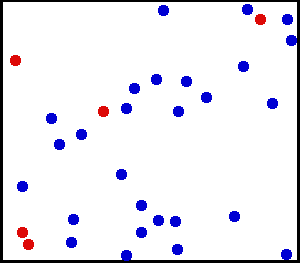- Momenutm
Momentum (usually symbolized by p) is a vector (see images) defined as follows:
p = m v,
-
where
Note fake links are used to display vector quantities. The link color makes the symbol stand out and underlines it which is something like undersquiggle symbol for vector.
The magnitude of a vector is the symbol without the fake link.
The (instantaneous) time rate of change of momemtum p is symbolized
dp -- dtWhich is a calculus notation---but we are NOT doing calculus, merely using the symbol that is commonly used for the time rate of change of momentum p.If mass m is constant,
dp -- = ma dtNewton's 2nd law ``F=ma'' in more general form than introduced in Lecture 4: Newtonian physics isdp F = -- dt where F is the total force acting on an object.This expression allows for non-constant mass though we will seldom/never make use of that generalization in this course.
- Center of Mass
The center of mass of an object of whatever kind is a usefully defined point in the vicinity of the object. For some purposes, the object acts as if it were a point-mass at the center of mass.
Consider a system of particles that make up an object.
-
Question: ``Let's play Jeopardy: Any set of objects or a single
object that a physicist (or anyone else for that matter) chooses to
regard as one thing for some purpose/purposes.
The purposes usually are for calculation of properties including often
future and/or past behavior."
- system
- universe
- mass
What is a __________________, Alex?
Answer 1 is right.The particles could be bound pieces in a rigid solid or fluid elements in a sample of fluid (e.g., a drop: see images) in complex relative motion.
-
Actually drop is
a sort of quasi-semi-rigid object since the surface tension force gives
it quasi-semi-rigid shape.
The small parts (fluid elements) of the drop can be regarded as the parcticles of the system.
It doesn't really matter for what the particle size is for derivations, except that they are small compared to the object itself.
They have to be small enough that they can be accurately treated as point-masses.
This is guaranteed if one takes the particles small enough that the center of mass is independent of independent of the particle size.
We do NOT need quantum mechanics: the particles need never be that small for macroscopic objects.
But the particles could be very small.
Or somewhat larger like billard balls (see images).
Just as an illustration of a system of particles consider this classical-gas animation gif.
The gas is classical since the particles are acting like little billard balls (at least schematically).

A schematic movie of a confined gas.
The molecules have kinetic energy which can be measured by temperature.
The microscopic collisions of the molecules give rise to macroscopic pressure which is a force per unit area on any planar slice through the gas.
Credit: Greg L. According to Wikipedia permission is granted to copy, distribute and/or modify this document under the terms of the GNU Free Documentation License, Version 1.2 or any later version.
Download site: Wikipedia: Image:Translational motion.gif.
-
Question: The expression
sum_i x_imeans:- sum_i times x_i?
- sum up all the quantities x_i.
- take the product of all the quantities x_i.
- All of the above.
Answer 2 is right. - Center of Mass